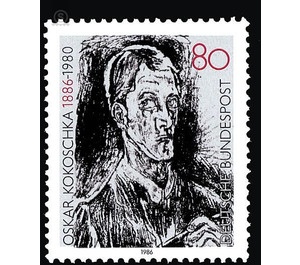100th birthday of Oskar Kokoschka - Germany / Federal Republic of Germany 1986 - 80 Pfennig
Theme: Calender
| Country | Germany / Federal Republic of Germany |
| Issue Date | 1986 |
| Face Value | 80.00 |
| Color | black |
| Perforation | K 13 3/4: 14 |
| Printing Type | 4-color offset printing |
| Stamp Type | Postage stamp |
| Item Type | Stamp |
| Chronological Issue Number | 1145 |
| Chronological Chapter | GER-BRD |
| SID | 30716 |
| In 45 Wishlists | |
On March 1, 1886, the painter Oskar Kokoschka, the leading master of expressionism, in Austria, in Pöchlarn a. d. Danube born. At the age of twenty-two, Kokoschka's works, which were exhibited at the »Vienna Art Show« in 1908, aroused admiration and protests for the first time. From his colorful designs for tapestry and for his youthful poetry "The Dreaming Boys" spoke a direct experience of the world and of the self, which was not covered by any conventions. Only a year later, he made public with portraits that made suggestively clear the psychic state of the sitter and indicated their future destinies in anticipation. International Kokoschka was known by participating in Herwarth Walden's "storm" in Berlin. In the legendary time-step of the same name, the first of Kokoschka's dramas appeared, which has been regarded as an early work of literary expressionism since its publication. The illustrations of this drama and numerous portraits proved the rank of Kokoschka as a draftsman. Some time after his return to Vienna Kokoschka met Alma Mahler, the widow of the composer Gustav Mahler. The passionate relationship with her is reflected in a series of masterful paintings, drawings and lithographs. Among the paintings, "The Windsbraut" stands out as the most important. It belonged to the Hamburger Kunsthalle until 1937, where it was confiscated as »degenerate« and sold to Basel. Kokoschka drew three lithographic episodes during the years of his association with Alma Mahler. The self-portrait depicted on the stamp - Kokoschka's first print-graphic self-portrait ever - introduces the cycle of pages to the cantata of Johann Sebastian Bach "Oh Eternity Du Donnerwort". In him, the artist shows himself upright and unbroken, despite the crisis in his relationship to his beloved wife, in spite of the "melancholy" which, in his own words, "gives shape to an experience as a report of the three years and thus out of the Sphere of an Everyday Love Relationship ". The portfolio for the Bach cantata was published three years after its creation in 1916 by Gurlitt, Berlin. Kokoschka was living in Dresden after an almost mortal wound in the First World War. From 1919 to 1923 he taught at the Dresden Academy. Then began a period of fruitful travel through Europe, North Africa and the Middle East. From them he returned, except to Vienna, again and again to Berlin, demanded and promoted by his art dealer Paul Cassirer and his successors. Only with the beginning of the National Socialist rule in Germany was it no longer possible for him to stay here. From Paris he contacted himself in an open letter in the "Frankturter Zeitung" in May 1933 for his persecuted Jewish colleague Max Liebermann. In 1934, Kokoschka left Austria, ruled by the Dollfuss regime. In 1938, he fled from the National Socialists from Prague to London. There he was elected president of the "Free German Cultural Association". At the end of the war he turned to the people of his host country for a just peace for the German people. In 1953 Kokoschka returned to the continent. He lived from then until his death in Villeneuve on Lake Geneva, painted again on travel and portrayed personalities from all over the world. His special concern was from 1953 to 1963 in his Salzburg School of Seeing the Youth, to whom he conveyed his idea of the experience of the world in seeing and of the freedom of the individual as the decisive quality of the human. Among his paintings, the 1956 view of Berlin and the 1954 triptych "The Thermopylae" painted for Hamburg University illustrate his commitment to freedom. In the Federal Republic of Germany numerous exhibitions of Kokoschka's work have been shown; The last major exhibition on Kokoschka's life could be presented with the help of the Foreign Office in Japan. In the Federal Republic of Germany Kokoschka's four-volume "Written Work," probably the largest of a painter in the twentieth century, appeared; Here, too, his letters are published scientifically. Among the recognitions of his life's work, Kokoschka's appointment to the Order "Pour le mérite" occupies a special place. The classification of this work as »Expressionism« Kokoschka himself has always been skeptical. For him it was a manifestation of life and experience itself. Image and word were available to him as forms of communication of this experience in the same way. (Text: Professor Dr. Heinz Spielmann, Museum of Arts and Crafts, Hamburg)


